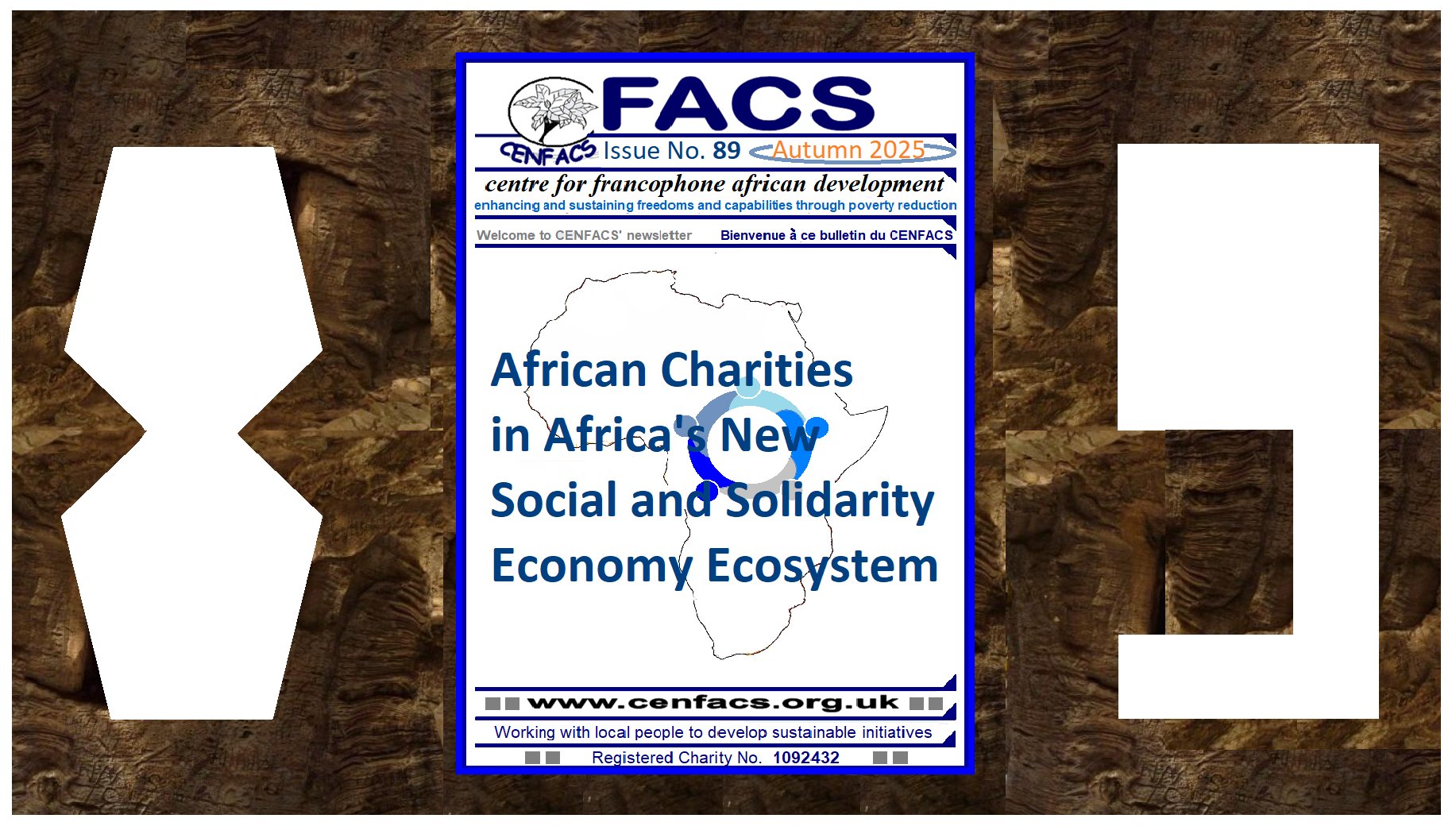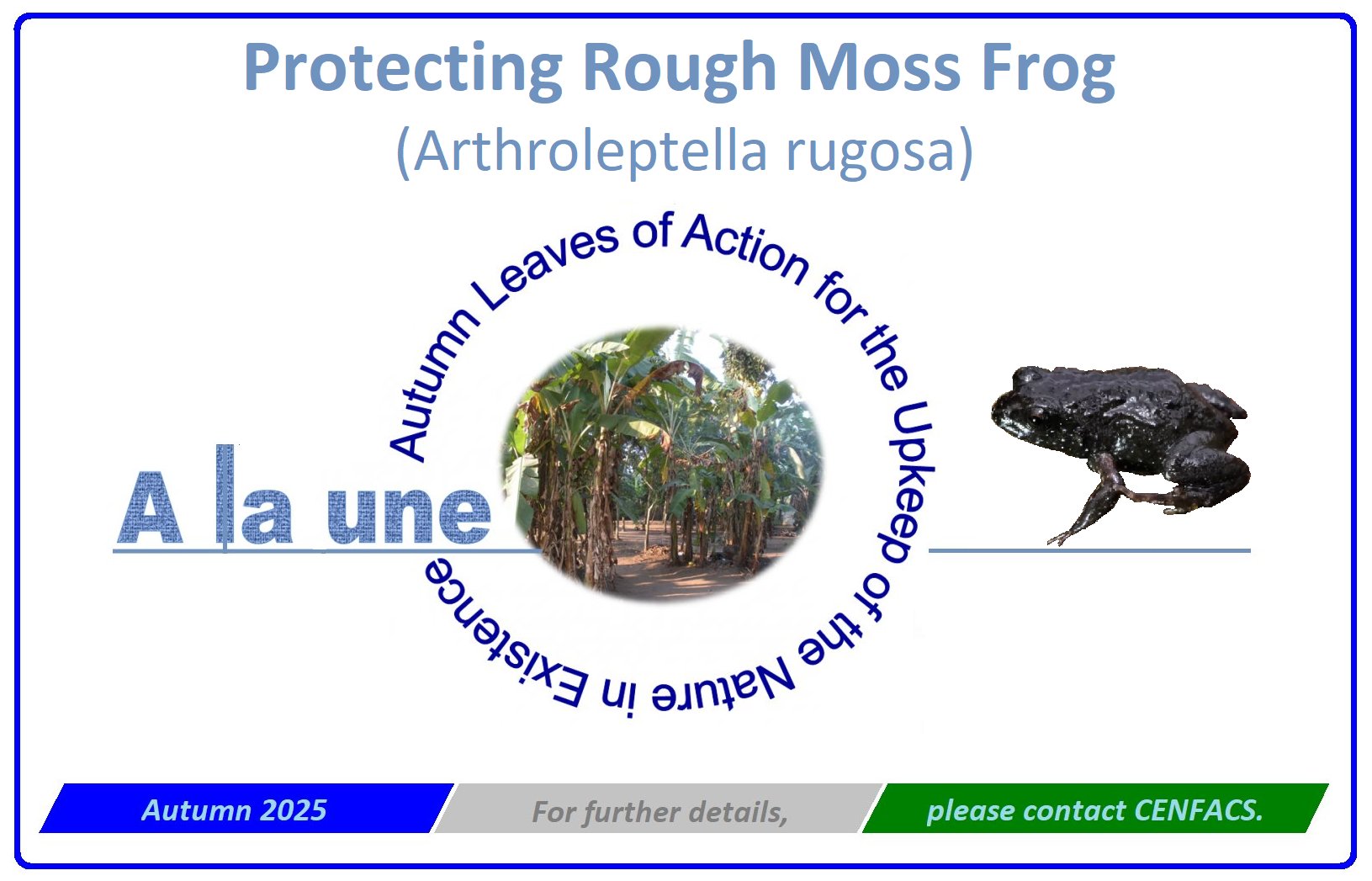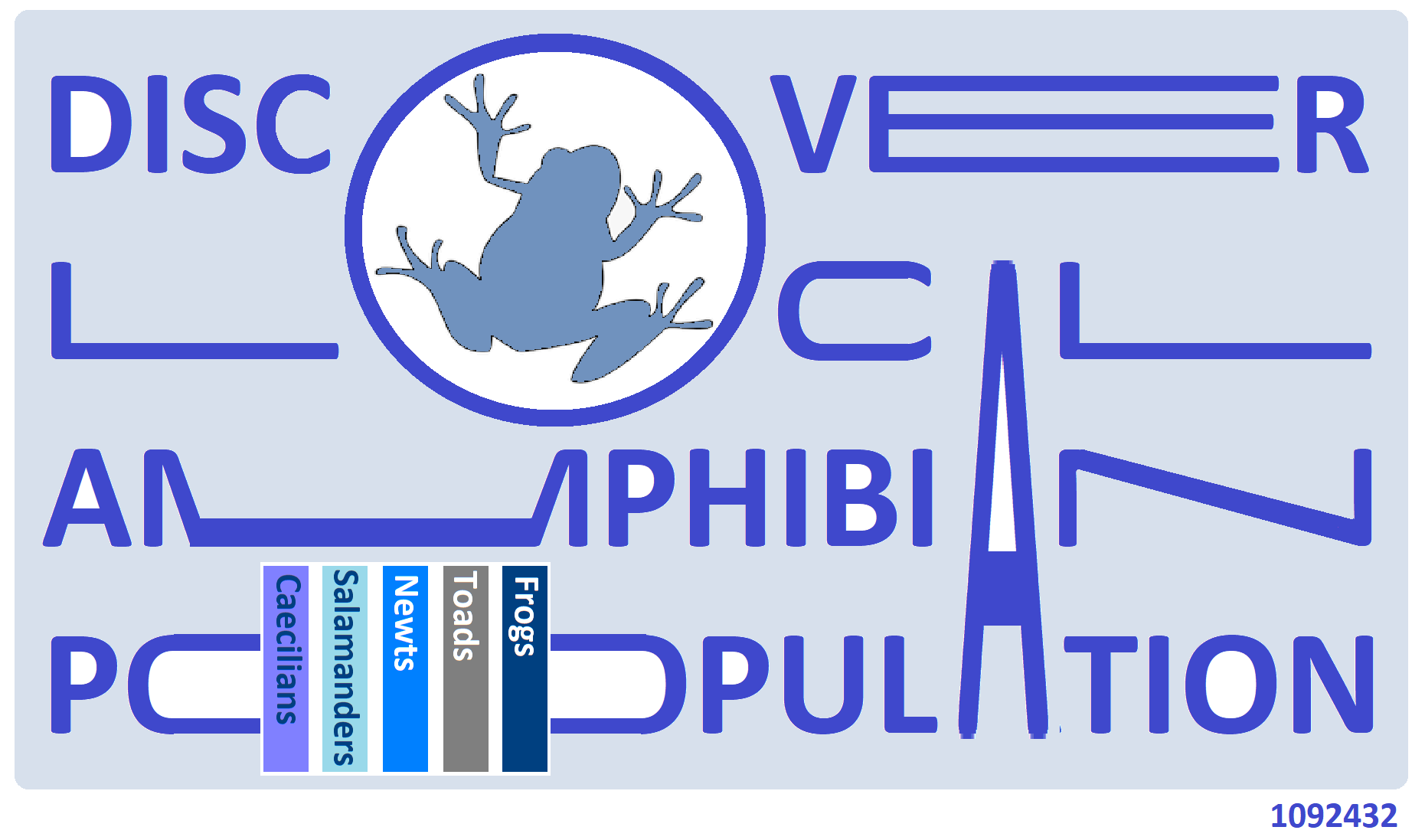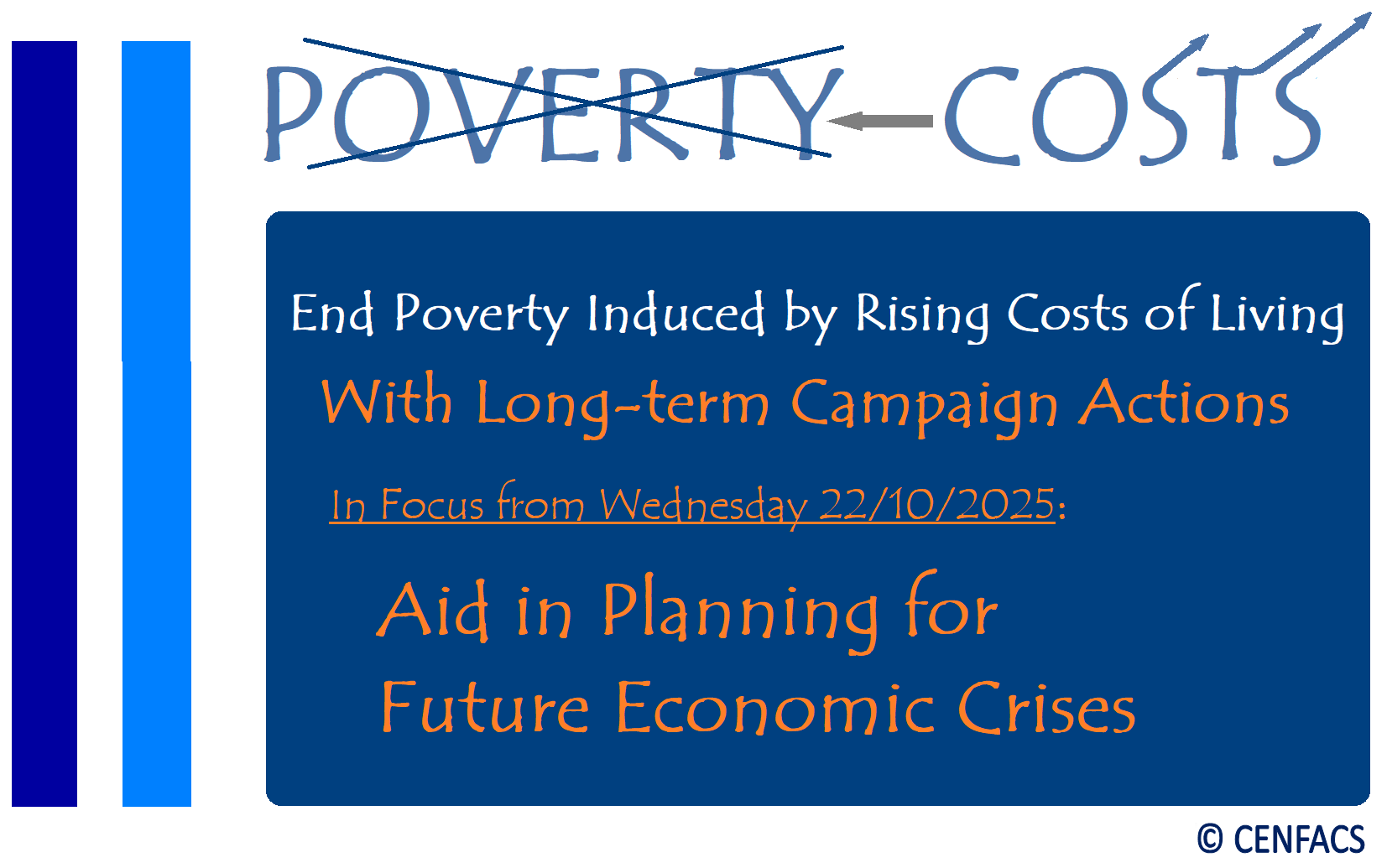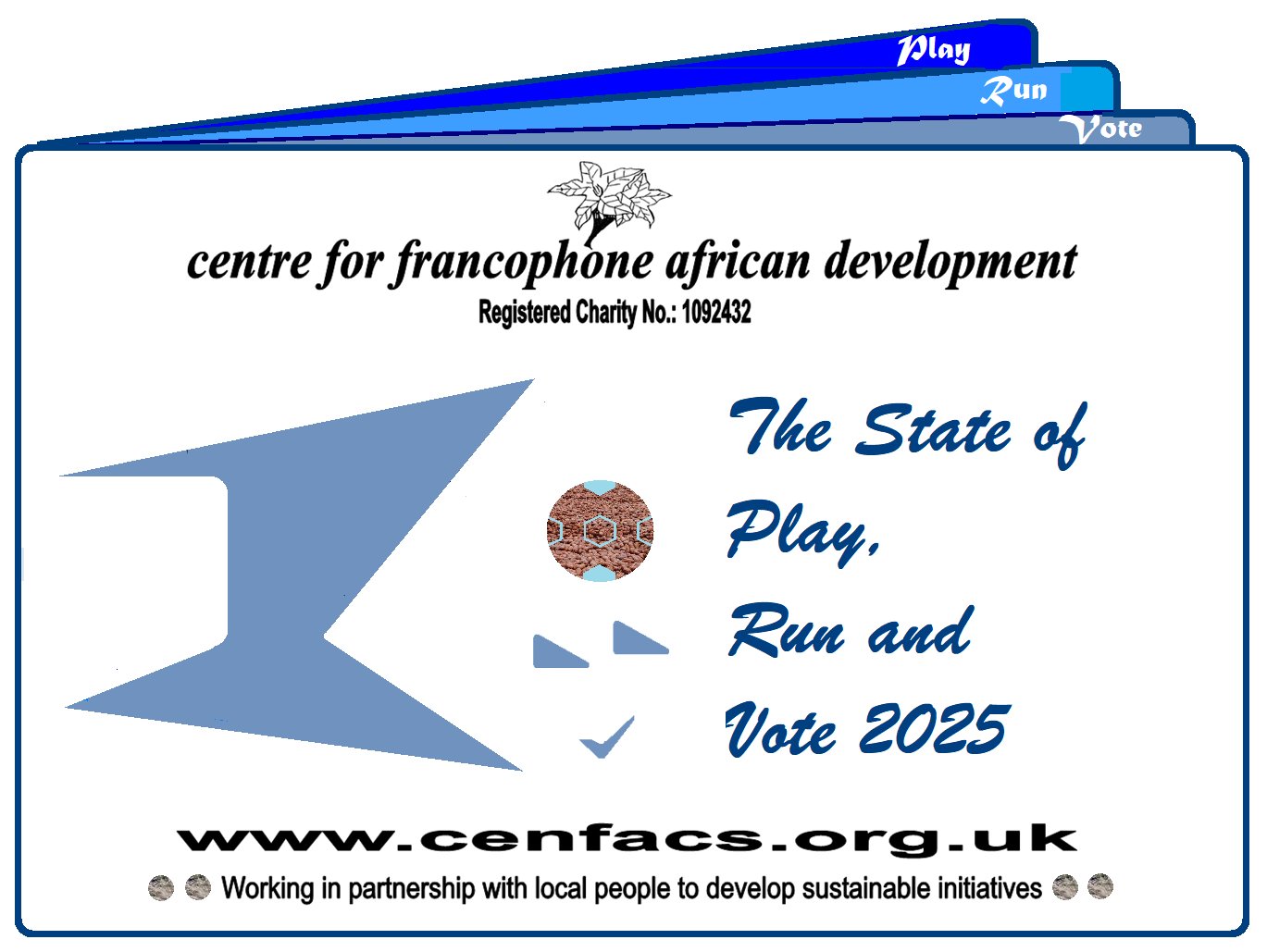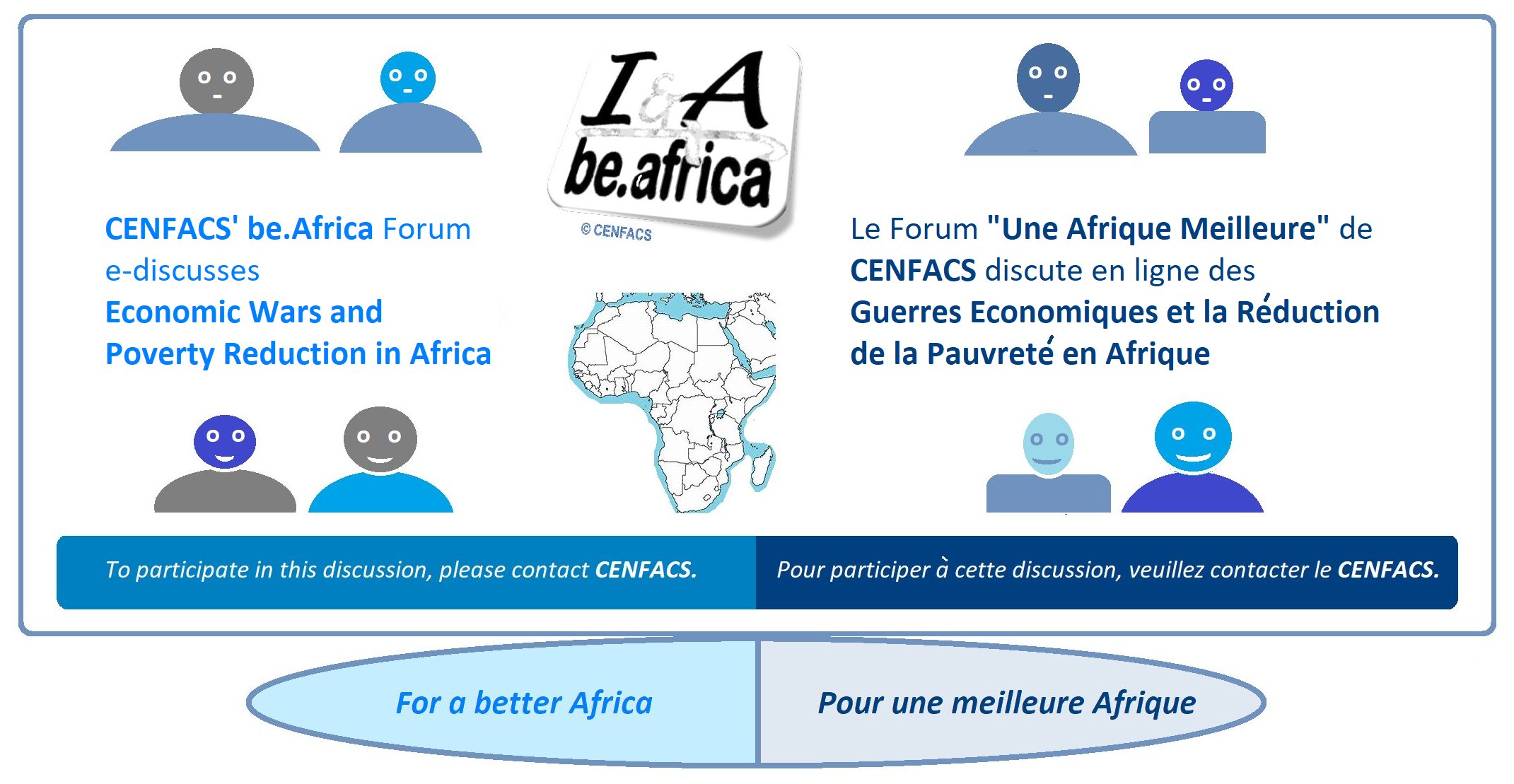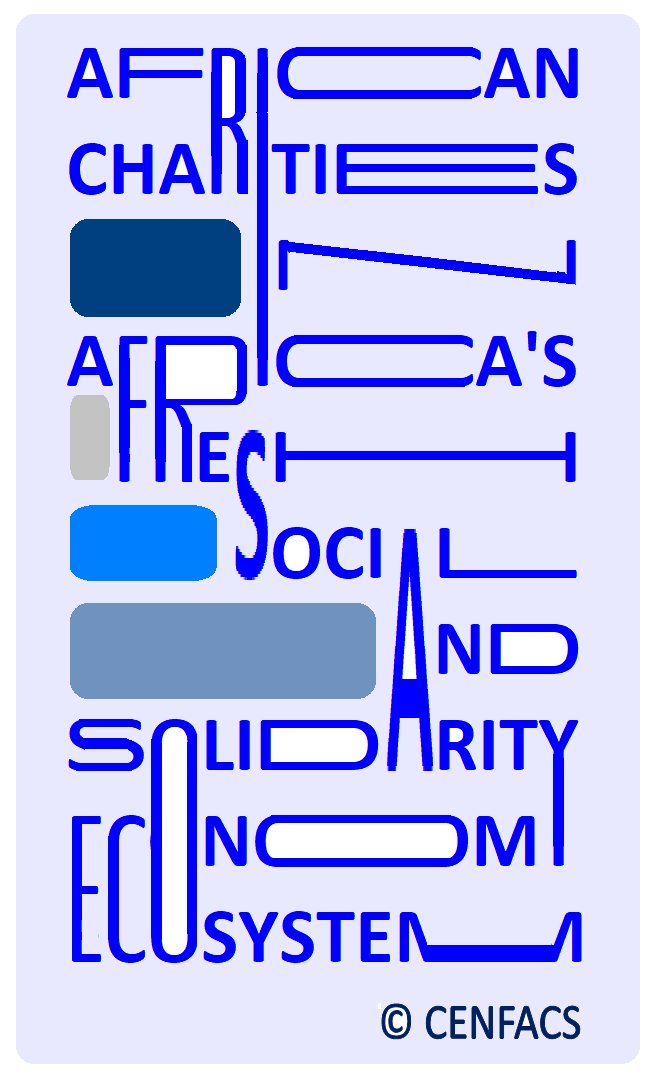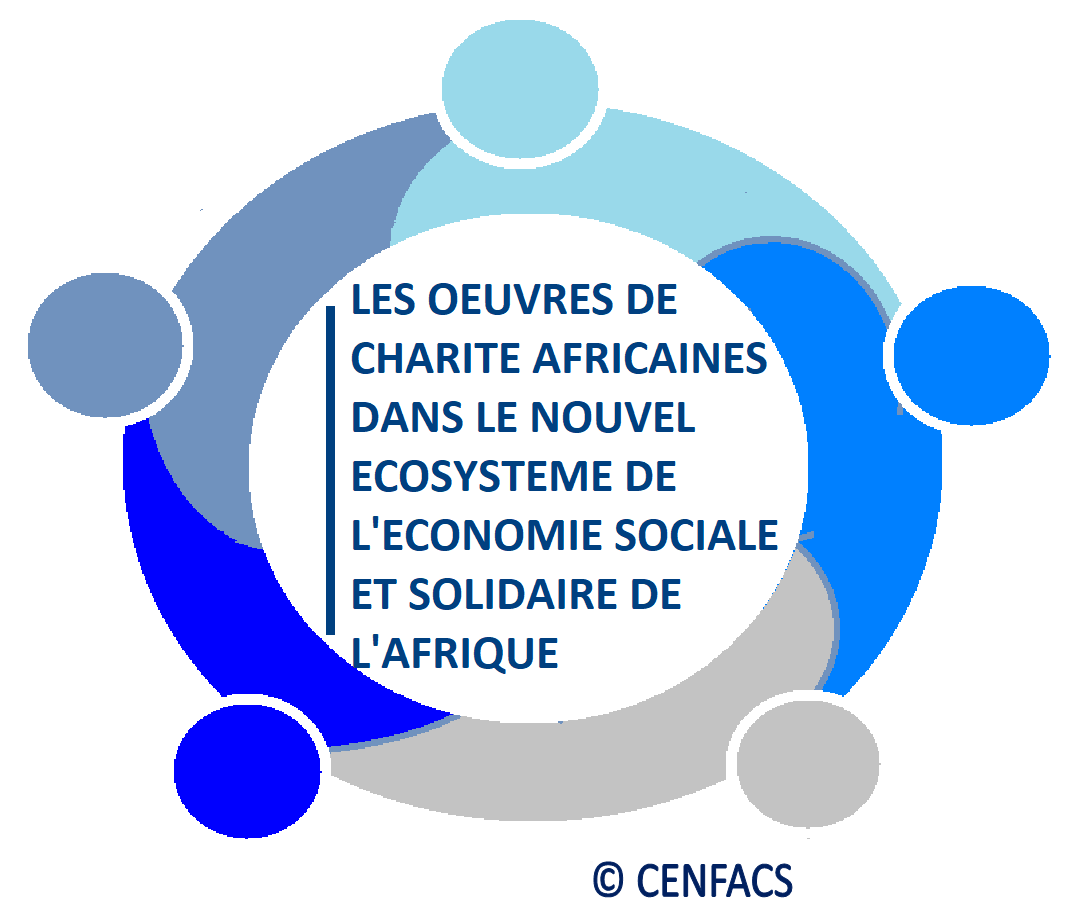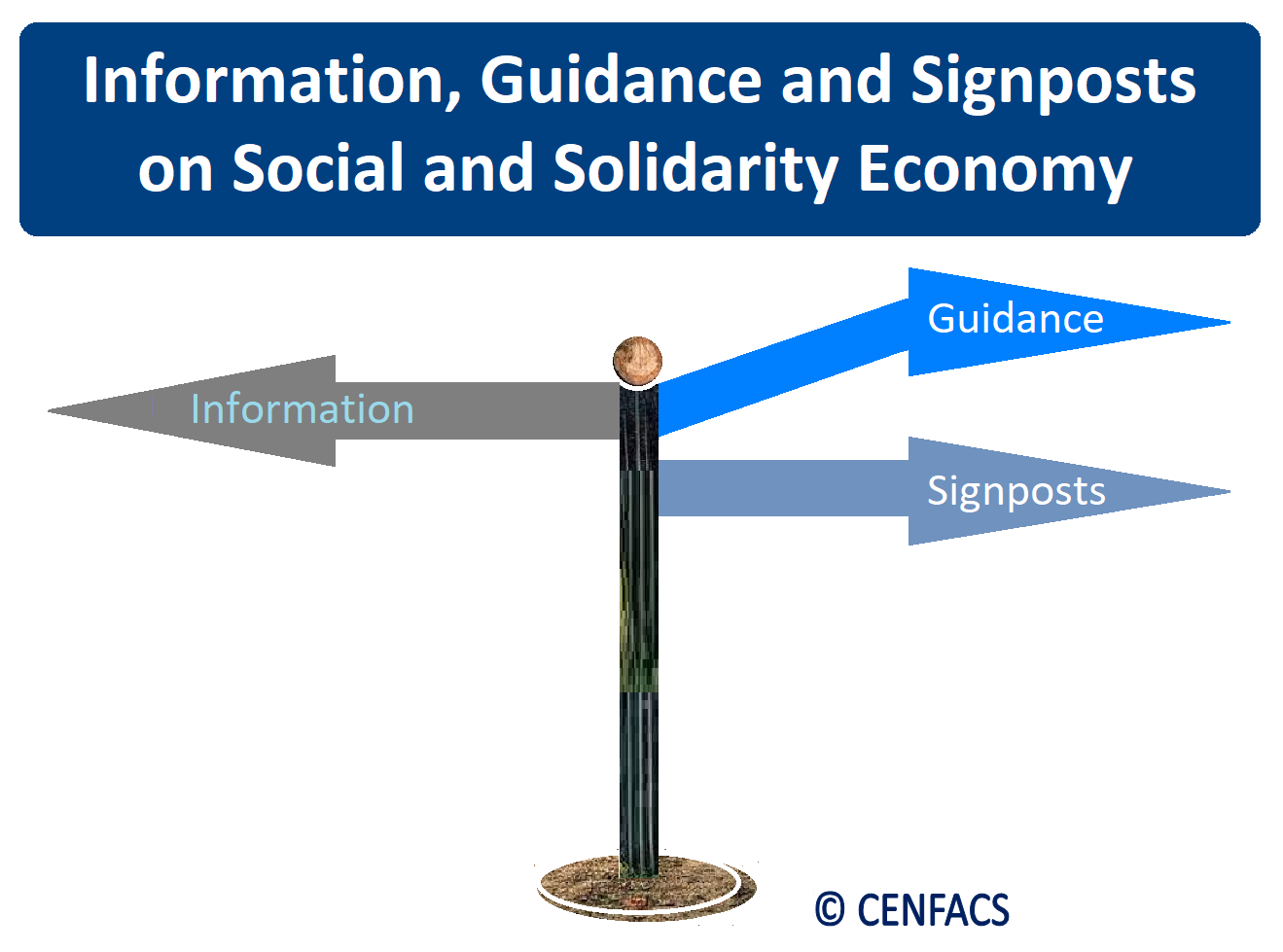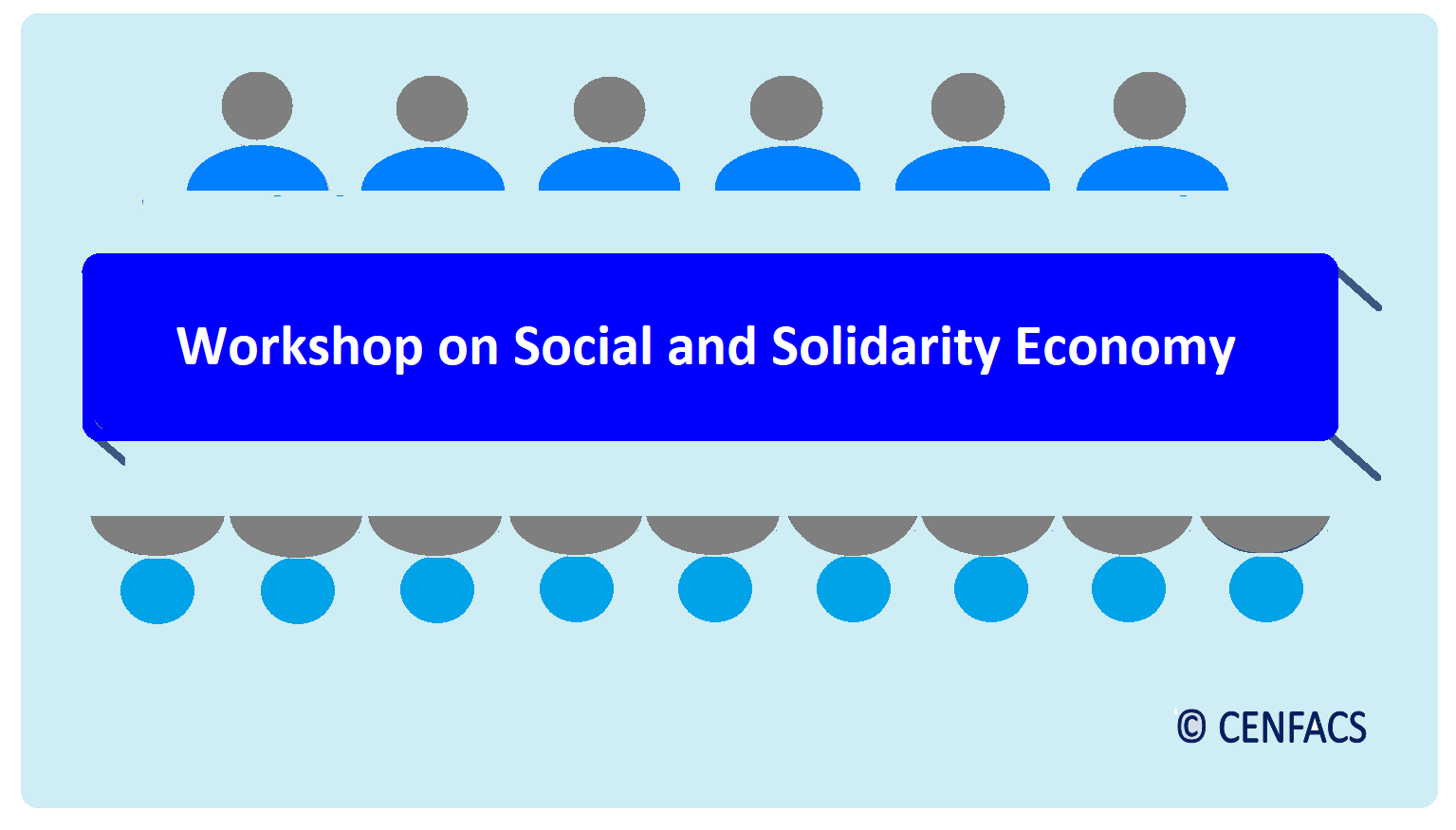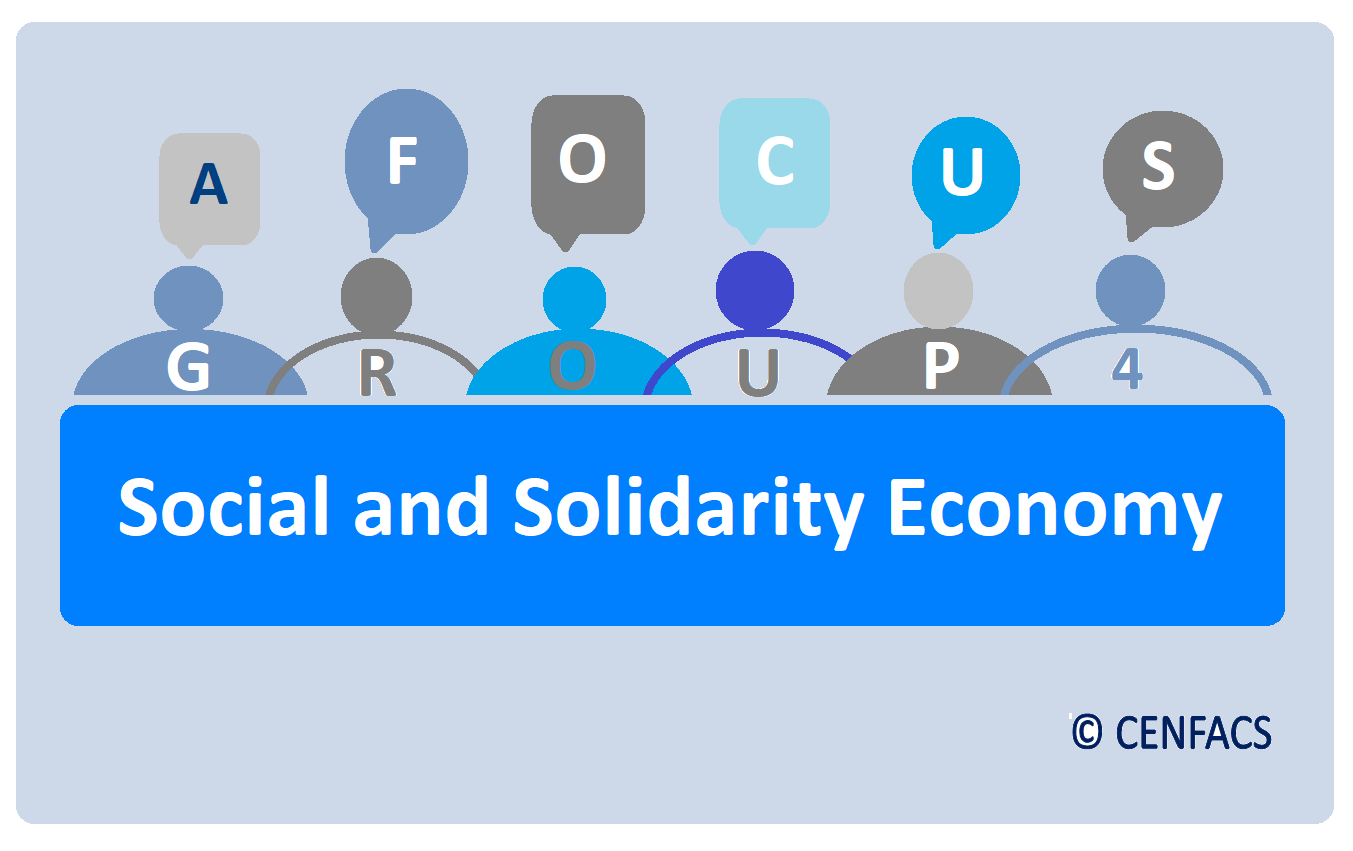Welcome to CENFACS’ Online Diary!
22 October 2025
Post No. 427
The Week’s Contents
• FACS, Issue No. 89, Autumn 2025, Issue Title: African Charities in Africa’s New Social and Solidarity Economy Ecosystem
• “A la une” (Autumn Leaves of Action for the Upkeep of the Nature in Existence) Campaign and Themed Activities – In Focus for Week Beginning 20/10/2025: Protecting Rough Moss Frog (Arthroleptella rugosa)
• Campaign to End Poverty Induced by High Costs of Living through Long-term Actions – In Focus from 15/10/2025: Aid in Planning for Future Economic Crises
… And much more!
Key Messages
• FACS, Issue No. 89, Autumn 2025, Issue Title: African Charities in Africa’s New Social and Solidarity Economy Ecosystem
In the 88th Issue of FACS, it was about finding alternative funding sources so that African Charities could continue their mission of reducing poverty in Africa since foreign and international aid cuts forced them to look for alternatives, in particular to craft new funding and business models. We are still working on alternative developments that would enable African Charities to deliver their mission. We are approaching these alternative developments from the perspective of ‘sociology.institute’ (1), which explains that
“Alternative development models can be understood as a reaction to the limitations of traditional approaches. These alternative models prioritise human well-being, environmental sustainability, and the preservation of local cultures”.
We are as well working on alternative economic systems. Alternative economic systems can be understood, according to ‘auditingaccounting.com’ (2), as
“The different ways societies organise the production, distribution, and consumption of goods and services. Each system has distinct structures, values and methods for managing resources. Common economic systems include capitalism, socialism, communism, mixed economies, and traditional economies. Each system influences economic activity and social outcomes differently, reflecting diverse approaches to resource management and societal goals”.
In addition, there are newly emerging alternative economic forms in which we are interested. Among these emerging forms, ‘koloo.at’ (3) names these three ones: the donut economy, the common good economy, and the post-growth economy (or degrowth).
These alternative development models, economic systems and forms have contributed to the shaping of the 89th Issue of FACS.
In the 89th Issue of FACS, it is about going beyond the limitations of traditional economic approaches by dealing with alternative economies or spaces that can be favourable to African Charities, particularly CENFACS‘ Africa-based Sister Organisations (ASOs), not only to keep on reducing poverty, but to possibly end it in Africa. The 89th Issue draws its contents from alternative economies. There are many alternative economies or spaces. The alternative economy or space that we are interested in is the Social and Solidarity Economy (SSE). What is SSE?
There are various definitions of SSE. Without listing all them, let us refer to the one given by the Organisation for Economic Cooperation and Development (4); definition which is:
“The SSE is an economic formation that aims to improve the quality of life of a region or community based on solidarity. It seeks to address and transform exploitation under capitalist economics and the large-corporation, large-shareholder-dominated economy”.
SSE operates in specific place or region. We are interested in SSE that operates in Africa, that is Africa’s ecosystem of SEE. The Social and Solidarity Economy Ecosystem (SSEE) is perceived here from the perspective of ‘socialchangeinnovators.com’ (5) as
“A framework that clarifies the core notions of the social and solidarity economy, along with related concepts such as social economy, social enterprise, and social innovation. It aims to explain what these concepts are and understand how they have evolved in recent decades”.
The 89th Issue is about how African Charities can stand out of the crowd from the structural advantages of SSE models or ecosystems. Among these advantages are job creation, community-driven capital flows, systems alignment, collective ownership, democratic-making, and solidarity-based relationships within various organisations making the SSE. As Linda Lundgaard Andersen et al. (6) put it,
“Solidarity economy is a heterospace for economic activities and solidarity economic relations to people’s interactions when building the livelihood”.
For Africa’s SSE Ecosystem to function as heterospace it requires that entities engaged in economic, social and environmental activities in it have interactions and exchanges between them while serving the collective and/or general interest.
The West Africa Civil Society Institute (7) states that
“The African Development Bank estimates that local giving could contribute up to US $400 billion to Africa’s Gross Domestic Product by 2030″.
Likewise, ‘africa.com’ (8) argues that
“Across Sub-Saharan Africa, social enterprises are estimated to directly create between 28 and 41 million jobs”.
Despite the lack of dedicated statistical frameworks hindering precise measurement, the above-mentioned estimated figures highlight the significant potential of domestic philanthropic and charitable efforts to fuel SSE as well as reduce poverty in Africa. African Charities play and can play a key role in the SSE by focusing on community well-being and social impact over profit, bridging service gaps by providing essential services like care, creating inclusive environments, and fostering democratic governance within the SSE ecosystem.
The 89th Issue refers to the key theoretical underpinnings of the SSE which reject pure profit-maximisation to favour social impact and human values. It also refers to theories of equity, promotion, democracy and sustainability. Some of these theories that reject pure profit-maximisation have been highlighted by Linda Lundgaard Andersen et al. (op. cit.) who mention Karl Polanyi in these terms:
“The economy theory offered by Karl Polanyi claims that economic systems based upon the collaborative elements of reciprocity and redistribution historically precedes that of the utilitarian approach to the market”.
They also refer to the democratic theory developed by thinkers like Jurgen Habermas and John Dewey.
The 89th Issue takes into account SSE models or ecosystems which include cooperatives, mutuals, associations, non-profits, social enterprises and fair trade initiatives; while approaching ASOs in terms of the dynamism they can bring to SSE for a systemic transformation of the current economic system to system that favours poverty reduction.
Because SSE models or ecosystems provide an environment for alternative forms of capital, the 89th Issue investigates how ASOs can benefit from alternative funding sources stemming from SSE space in Africa. It also considers ASOs capital structure, deployment and measurement in Africa.
Since there is the primacy of people and social purpose over capital as one of they key values of SSE, the 89th Issue is the experience of alignment of capital flows with impact into African Charities with social value creation and the needs of their users.
Africa’s shift to the social economy implies African Charities to participate in strategic move towards scalable, inclusive and future-ready systems. The 89th Issue provides the feelings of African Charities about their experience in this move and how it will affect their project beneficiaries.
SSEEs are also thought to be community-embedded economic models and areas underserved by formal systems. The 89th Issue examines how the participation of ASOs in Africa’s SSEE helps meet the needs of those living in informal economy.
Far from being an exposé on Africa’s new experience about SSE, the 89th Issue explores ASOs’ attempt to build independence from perpetual grants system in order to improve their participation in SSEE in Africa while delivering their mission in a space that is inclusive, scalable and future-oriented.
To get further insights into the Issue No. 89, please read the summaries presented under the Main Development section of this post.
• “A la une” (Autumn Leaves of Action for the Upkeep of the Nature in Existence) Campaign and Themed Activities – In Focus for Week Beginning 20/10/2025: Protecting Rough Moss Frog (Arthroleptella rugosa)
To help Protect Rough Moss Frog (Arthroleptella rugosa), we have composed our note around the following headings:
σ What is Rough Moss Frog (Arthroleptella rugosa)?
σ The conservation status of Rough Moss Frog (Arthroleptella rugosa)
σ What can be done to Protect Rough Moss Frog (Arthroleptella rugosa).
In addition, we shall provide the themed activity we have planned for this week. This themed activity is about Discovering Local Amphibian Population.
Let us look at each of the headings of this note.
• • What Is Rough Moss Frog (Arthroleptella rugosa)?
Rough Moss Frog (Arthroleptella rugosa) is a tiny critically endangered frog species native to the Klein Swartberg Mountain in South Africa. It is known for its rough, granular skin, which provides excellent camouflage in its habitat of seeps and wet areas, and it faces significant threats from invasive plants and habitat loss.
• • The Conservation Status of Rough Moss Frog (Arthroleptella rugosa)
Rough Moss Frog (Arthroleptella rugosa) is listed as Critically Endangered due its extremely limited range and severe threats. According to Hannah Steiner (9),
“One of the most pressing threats to frogs today is the chytrid fungus, a deadly skin fungus that has moved across the globe causing amphibian declines in Australia, South America, North America, Central America, New Zealand, Europe, and Africa killing frogs by the millions. The chytrid fungus is responsible for over 100 frog and other amphibian species extinctions since the 1970’s”.
Rough Moss Frog (Arthroleptella rugosa) experiences threats due to its habitat degradation from invasive plants, such as pine and hakea, which alter the hydrology of the seepages and increase the frequency of intense fires. Intense and unplanned fires are another major threat.
• • What Can Be Done to Protect Rough Moss Frog (Arthroleptella rugosa)
To protect Rough Moss Frog (Arthroleptella rugosa), there are many types actions that can be taken and that can be grouped under conservationist and public actions.
# Conservationist actions include the following:
σ Controlled ecological burns to manage its habitat
σ Creativity firebreaks
σ Establishing contract nature reserves to protect critical areas.
# Public actions, which can help all frogs, can involve:
σ Creating backyard ponds
σ Providing national cover like logs and leaves
σ Avoiding pesticides
σ Protecting local wetlands
Etc.
Both conservationist and public actions are complementary in order to protect Rough Moss Frog (Arthroleptella rugosa).
Besides that, one can donate to causes relating to the protection of Rough Moss Frog (Arthroleptella rugosa).
The above actions are the few ones. There is more that can be done to protect Rough Moss Frog (Arthroleptella rugosa). To stay within the scope of this note, we can limit ourselves to the above-mentioned actions or steps to Protect Rough Moss Frog (Arthroleptella rugosa).
• • Add-on Activity of the Week’s Campaign: Discover Local Amphibian Population
This discovery can be done by undertaking the following:
σ Searching for native species in local habitats like ponds and wetlands (by looking for frogspawn or toadspawn in the water, as well as in the back gardens where toads can be found);
σ Checking with national organisations like the Amphibian and Reptile Conservation or the National Amphibian Survey;
σ Consulting publicly available science databases.
You can as well report on your findings or share your sightings so that other people can find amphibians.
Those who may be interested in taking part in this discovery themed activity can contact CENFACS.
To find out more about the entire “A la une” Campaign and Themed Activities, please communicate with CENFACS.
• Campaign to End Poverty Induced by High Costs of Living through Long-term Actions – In Focus from 15/10/2025: Aid in Planning for Future Economic Crises
Aid in Planning for Future Economic Crises is the fourth long-term campaign action of our Campaign to End Poverty Induced by High Costs of Living. To tackle this campaign action, let us start with the types of long-term economic crises that the people who are suffering from high costs of living may face, then look at what strategies they can use to plan for these future economic crises.
• • Long-term Economic Crises
Long-term Economic Crises could stem from escalating trade tensions, financial market adjustments, policy shifts, and growing government and private debt. In its 20th Edition of The Global Risks Report 2025, The World Economic Forum (10) provides the following economic risks over a 2- and 10-year horizon:
Asset bubble burst, concentration of strategic resources and technologies, crime and illicit economic activity, inflation, debt, disruptions to a systematically important supply chain, disruptions to critical infrastructure, economic downturn, talent and/or labour shortages.
The World Economic Forum also mentions other risks that one may consider as they may have economic content or connotation.
Other potential risks include geopolitical instability, climate-related shocks, and technological disruptions, such as supply chain issues or cyberattacks. Experts also point to long-term pressures like aging populations and rising health and pension costs as significant risk factors.
Both 2- and 10-year period risks can exacerbate the existing cost-of-living crisis and poverty. That is why it makes sense to have strategies to deal with these future or long-term economic crises or risks.
• • Strategies to Aid in Planning for Future Economic Crises
To aid in planning for future economic crises, households can implement the following strategies:
σ Budgeting: Track income and expenses, set saving goals, and regularly review and adjust the budget as necessary;
σ Emergency fund: Create an emergency fund that ideally covers three to six months of living expenses and is used only for true emergencies;
σ Financial awareness: Stay informed about economic conditions by reading financial views, signing up for financial newsletters, and following economic indicators like interest rates, inflation and unemployment rates;
σ Financial preparedness: Develop a financial safety net by building an emergency fund, investing wisely, and managing debt;
σ Crisis support: Seek discretionary crisis support/help if your are eligible.
These strategies, which may not be exhaustive, can help households planning for future crises to navigate financial uncertainties and maintain their living when future crises strike.
Those who will be interested in this fourth campaign action and would like to join it, they should not hesitate to contact CENFACS.
Those who have any enquiries and or queries about Campaign to End Poverty Induced by High Costs of Living through Long-term Actions, they can address them to CENFACS.
Extra Messages
• Happening on 27 and 28 October 2025: Making Memorable Positive Difference (MM+D) Project – In Focus: History of Africa’s Green Industry
• The State of Play, Run and Vote 2025
• CENFACS’ Climate Talks Follow-up Project & International System for Poverty Reduction (World Anti-poverty System)
• Happening on 27 and 28 October 2025: Making Memorable Positive Difference (MM+D) Project – In Focus: History of Africa’s Green Industry
There will be Two Days of the History of Africa’s Green Industry as follows:
∝ One day of identifying and profiling historical African figures (including green industry activists and advocates) in Africa’s green industrial sector
∝ One day of assessing the historical role of green industry in reducing green poverty and in enhancing sustainable industrial development in Africa.
Let us summarise the contents of each day’s work.
• • Day of Heritage/Patrimony/Industrialists/Activists/Advocates (27 October 2025): History of Those Who Shaped the Green Industry in Africa
On the first day of our MM+D, which is the Heritage and Patrimony Day, we shall remember those talented and skilful African industrialists, activists, and advocates of green industry for their admirable green and sustainable skills and techniques, which were passed on to other generations. It is the day of learning a brief outline or sketch in terms of their profiles and their historical green and sustainable industrial development work.
Through the study of their profiles and green industrial work, it will be possible to know the kind of role they played or did not play in the development of green industry in Africa. They are part of Africa’s heritage and patrimony as they represent Africa’s historic green industry traditions and Africa’s wealth, that transcends many eras and was passed on to other generations.
Since we are in 2025 as the Year of African Cultural and Heritage, Heritage and Patrimony Day of MM+D will also be about looking at the links between Africa’s culture and the green industry, between Africa’s heritage and the green industry.
The links between Africa’s culture and the green industry will be about emphasizing sustainable practices rooted in traditional knowledge, like sustainable agriculture and resource management, and the adoption of new technologies that align with cultural values of community and resilience in Africa. It is also about how green policies were fitted into Africa’s culture; policies that leverage Africa’s vast natural and human resources to develop green value chains in sectors like renewable energy, green construction, and agriculture, aiming for both climate action and economic development to address challenges such as poverty and food security.
The connections between Africa’s heritage and the green industry will consist of acknowledging Africa’s rich heritage which is associated with the green industry through its abundant renewable energy sources and critical minerals, which are essential for the global clean energy transition, as well as through the potential to develop local, sustainable economies. This heritage also includes traditional knowledge of land and resource management which can inform sustainable practices and community-led conservation efforts, fostering both ecological health and economic development.
• • Legacies and Gifts Day (28 October 2025): The Historical Role of Green Industry in Reducing Green Poverty and in Enhancing Sustainable Industrial Development in Africa
On the Legacies and Gifts Day of MM+D, we shall learn what was handed on to the current generations in terms of knowledge and techniques to reduce green poverty and enhance sustainable industrial development in Africa by the industrialists, green activists and advocates of the past. We shall as well recollect in our memory what these past green industry players gave to today’s green economy and industrial development in Africa. In other words, we shall study the legacies and gifts of green industry in reducing green poverty and creating green wealth in Africa.
Still on the Legacies and Gifts Day of MM+D, we shall discuss the legacies of Africa’s growing green industry in terms of sustainable industrial development. Its legacies include a shift in the global narrative of Africa, increased economic opportunities in green sectors, enhanced energy security, and the potential for a sustainable industrial development that leverages vast renewable resources. We shall as well talk about the gifts that African green industry offers. In particular, emphasis will be put on the gifts of sustainable growth, green poverty reduction, and job creation by focusing on renewable energy, sustainable agriculture, green infrastructure, and eco-tourism; leveraging Africa’s natural resources to achieve economic development without environmental degradation.
The above is this year’s MM+D theme. To engage with this theme and or support this project, please contact CENFACS on this site.
• The State of Play, Run and Vote 2025
• • What Is the State of Play, Run and Vote?
It is an annual report on the situation of CENFACS’ three All Year Round Projects or Triple Value Initiatives (that is; Play, Run and Vote Projects). This situation is normally provided by all those who are using these projects or initiatives through the information or data they give on how their individual project is doing. It is more than just telling us your 3 bests of the year in terms of Play, Run and Vote Projects.
• • How to Contribute to This Year’s State of Play, Run and Vote
Let us summarise the way of contributing to each project.
• • • Playing CENFACS’ Poverty Relief League
If you are playing CENFACS’ Poverty Relief League as part of your Play project, you could let us know the teams that are in the league, the points each has scored so far, their performance, the top performer, etc. You could as well update us about any upcoming events relating to your play or reveal any new games/tournaments you have in mind.
So, your State of Pay refers to the current status or progress of your Play project including a series of carried out games with scores and incoming fixtures.
• • • Running for Poverty Reduction
If you are Running for Poverty Reduction, you could share with us you state of running which could contain things such as the number of race runners, the popularity of your Run project, out/indoor activities you undertook, your running statistics, the fastest runners for your Run project, etc. You can mention the benefits of running and running participation as well.
Summarily, your State of Running Report indicates the overall runners’ participation, the interest from non-runners, and trend about the category of runners for those who choose to run in group.
• • • Voting Your International Development and Poverty Reduction Manager of 2025
If you are in the process of Voting Your International Development and Poverty Reduction Manager of 2025, you could mention the number of voting intentions, the course of actions you are taking to choose among several possible alternative options and competing candidates. The goal is to find the best fit for the role based on skills, experience, and cultural alignment. You can explain your selection criteria and the way you screen candidates against this criteria.
You could also inform us if your votes are rational or irrational, if you use social choice theory, your voting system, the rules of voting and how you will reach your decision on International Development and Poverty Reduction Manager of 2025.
Briefly, your State of Voting is the series of steps you take to choose the most suitable candidate to be the best International Development and Poverty Reduction Manager of 2025.
If you use orange, blue, brown, green and grey spaces as social prescribings in your Play or Run or Vote project; you could also share this information with us to make the State of Play, Run and Vote 2025.
The above exemplifies how one can contribute to this year’s State of Play, Run and Vote. To share your contribution, please do not hesitate to contact CENFACS.

• CENFACS’ Climate Talks Follow-up Project & International System for Poverty Reduction (World Anti-poverty System)
We are continuing to jointly work our Climate Talks Follow-up Project and our Campaign for an International System for Poverty Reduction (or World Anti-poverty System) as we are preparing to follow next month’s global climate talks (COP30).
Our Climate Talks Follow-up Project is still in Phase 3.4. which is known as Taking Climate Protection and Stake for African Children at the Implementation Level with Implementation Sub-phase.
We are look at how COP30 priorities could be enhanced if we had an International System for Poverty Reduction (or World Anti-poverty System). What are those COP30 priorities we are talking about?
• • COP30 Priorities
Amongst the priorities, we can mention the following three ones:
σ Accelerating the implementation of climate solutions
σ Reinforcing multilateralism and cooperation
σ Connecting climate change to people’s daily lives and economies.
• • Enhancement of COP30 Priorities within an International System for Poverty Reduction (or World Anti-poverty System)
Regarding the acceleration of the implementation of climate solutions, if the world (and Africa in it) had a Word Anti-poverty System, there would be more and better opportunities in green energy for the poor, increased agricultural resilience, and the provision of more essential services like clean energy access for the poor.
Concerning the reinforcement of multilateralism and cooperation, if the world (and Africa in it) had a Word Anti-poverty System, technical and financial assistance, policy support, and trade facilitation would increase with the prospect of lifting more people out of poverty.
With respect to connecting climate change to people’s daily lives and economies, if the world (and Africa in it) had a Word Anti-poverty System, climate protection of livelihoods, the creation new opportunities and climate resilience of poor communities would be made much easier.
CENFACS‘ WAS (World Anti-poverty System) Campaign includes this enhancement, which system reforms of global institutions can help better achieve. CENFACS always campaign for an International System for Poverty Reduction, which does not exist, to serve the poor and bridge the gap in the institutions of Bretton Woods.
An International System for Poverty Reduction is the missing piece from these institutions. System reforms, like the ones to the global financial architecture and others, will help to mobilise and channel both funds and technologies for climate transitions in places (like Africa) where these transitions are unaffordable. Much better, an International System for Poverty Reduction will level up the plain field by providing voices and spaces for the poor to win the battle against poverty including poverty induced by climate change.
If you believe in reforming the global institutional architecture and in a new International System for Poverty Reduction, you can support our joint work on Following Climate Talks and Setting up a New International System for Poverty Reduction (or World Anti-poverty System).
To support, please contact CENFACS.
Message in English-French (Message en Anglais-Français)
• CENFACS’ be.Africa Forum E-discusses Economic Wars and Poverty Reduction in Africa
To introduce this e-discussion, let us provide the definition of economic war. What is economic war?
According to ‘britannica.com’ (11),
“Economic warfare [refers to] the use of, or the threat to use, economic means against a country in order to weaken its economy and thereby reduce its political and military power. Economic warfare also includes the use of economic means to compel an adversary to change its policies or behaviour or to undermine its ability to conduct normal relations with other countries. Some common means of economic warfare are trade embargoes, boycotts, sanctions, tariff discrimination, the freezing of capital assets, the suspension of aid, the prohibition of investment and other capital flows, and expropriation”.
From this definition, it is possible to argue that some of the wars that happened in Africa can be treated as economic wars as well.
For instance, the trade disputes between nations such as the prolonged milk trade war between Kenya and Zambia, or conflict economies (that is, conflicts fuelled by control over natural resources) like the Democratic Republic of Congo’s second war and the current conflicts in its eastern part (Kivu region), or resource-driven conflicts (e.g., North and South Sudan conflicts which were driven by the control of oil resources) can be interpreted as economic wars.
These economic wars can have impacts on the work of poverty reduction in Africa. Indeed, economic wars under various forms – like wars of aggression, civil wars, and conflict involving external powers – can lead to severe economic contraction, increased poverty, and unemployment levels. These conflicts disrupt key sectors, exacerbate poverty and reduce the potential for economic growth. This is let alone the human toll in terms of casualties and fatalities. Our e-discussion is about them, about their impacts on the work of poverty in Africa where these economic wars happened.
The above is what our e-discussion is about. Those who may be interested in this discussion can join our poverty reduction pundits and/or contribute by contacting CENFACS’ be.Africa Forum, which is a forum for discussion on poverty reduction and sustainable development issues in Africa and which acts on behalf of its members by making proposals or ideas for actions for a better Africa.
To contact CENFACS about this discussion, please use our usual contact address on this website.
• Le Forum ‘Une Afrique Meilleure’ de CENFACS discute en ligne des Guerres Economiques et la Réduction de la Pauvreté en Afrique
Pour introduire cette discussion en ligne, fournissons la définition de la guerre économique. Qu’est-ce qu’une guerre économique ?
Selon ‘britannica.com’ (11),
« La guerre économique [se réfère à] l’utilisation ou la menace d’utilisation de moyens économiques contre un pays afin d’affaiblir son économie et ainsi réduire son pouvoir politique et militaire. La guerre économique inclut également l’utilisation de moyens économiques pour contraindre un adversaire à changer ses politiques ou son comportement, ou pour saper sa capacité à entretenir des relations normales avec d’autres pays. Parmi les moyens courants de guerre économique figurent les embargos commerciaux, les boycotts, les sanctions, la discrimination tarifaire, le gel des actifs financiers, la suspension de l’aide, l’interdiction d’investissement et d’autres flux de capitaux, ainsi que l’expropriation. »
À partir de cette définition, il est possible de soutenir que certaines des guerres qui ont eu lieu en Afrique peuvent également être considérées comme des guerres économiques.
Par exemple, les différends commerciaux entre nations tels que la guerre prolongée du commerce du lait entre le Kenya et la Zambie, ou les économies de conflit (c’est-à-dire les conflits alimentés par le contrôle des ressources naturelles) comme la seconde guerre de la République Démocratique du Congo et les conflits actuels dans sa partie orientale (région du Kivu), ou les conflits liés aux ressources (par exemple, les conflits entre le Soudan du Nord et le Soudan du Sud qui étaient alimentés par le contrôle des ressources pétrolières) peuvent être interprétés comme des guerres économiques.
Ces guerres économiques peuvent avoir des impacts sur le travail de réduction de la pauvreté en Afrique. En effet, les guerres économiques sous diverses formes – comme les guerres d’agression, les guerres civiles et les conflits impliquant des puissances extérieures – peuvent entraîner une contraction économique sévère, une augmentation de la pauvreté et du chômage. Ces conflits perturbent les secteurs clés, aggravent la pauvreté et réduisent le potentiel de croissance économique. Cela sans parler du coût humain en termes de victimes et de pertes en vies humaines. Notre discussion en ligne porte sur ces guerres et sur leurs impacts sur les efforts de lutte contre la pauvreté en Afrique, là où ces guerres économiques ont eu lieu.
Ce qui précède est le sujet de notre discussion en ligne. Ceux ou celles qui pourraient être intéressé(e)s par cette discussion peuvent se joindre à nos experts en réduction de la pauvreté et/ou contribuer en contactant le ‘me.Afrique’ du CENFACS (ou le Forum ‘Une Afrique Meilleure’ de CENFACS), qui est un forum de discussion sur les questions de réduction de la pauvreté et de développement durable en Afrique et qui agit au nom de ses membres en faisant des propositions ou des idées d’actions pour une Afrique meilleure.
Pour contacter le CENFACS au sujet de cette discussion, veuillez utiliser nos coordonnées habituelles sur ce site Web.
Main Development
• FACS, Issue No. 89, Autumn 2025, Issue Title: African Charities in Africa’s New Social and Solidarity Economy Ecosystem
The contents and key summaries of the 89th Issue of FACS are given below.
• • Contents and Pages
I. Key Terms Relating to the 89th Issue of FACS (Page 2)
II. Theories Used in the 89th Issue of FACS (Page 2)
II. African Charities as Difference Makers from Structural Advantages of Africa’s New SSEE (Page 3)
III. African Charities’ Participation in Africa’s SSEE and Strategic Move (Page 3)
IV. The Potential Effects of Domestic Philanthropic Efforts and African Charities’ Actions on Africa’s SSEE and Poverty Reduction (Page 4)
V. African Charities, Capital Flows Alignment, Social Value Creation and Users’ Needs (Page 4)
VI. Comment les Organisations Soeurs Basées en Afrique (OSBA) peuvent tenter de construire leur indépendence financière au sein de l’écosystème africain de l’économie sociale et solidaire (EESSA) par rapport au système de subventions perpétuelles (Page 5)
VII. Comment les Organisations Sœurs Basées en Afrique peuvent jouer leur rôle au sein de l’EESSA pour desservir les zones mal couvertes par les systèmes formels (Page 6)
VIII. Survey, Testing Hypotheses, E-questionnaire and E-discussion on SSE (Page 7)
IX. Support, Tool and Metrics, Information and Guidance on SSE (Page 8)
X. Workshop, Focus Group and Booster Activity about SSE (Page 9)
XI. Giving and Project (Page 10)
• • Key Summaries
Please find below the key summaries relating to the 89th Issue of FACS from page 2 to page 10.
• • • Key Terms Relating to the 89th Issue of FACS (Page 2)
There are three terms used in the context of this Issue of FACS. These terms are African charities, social and solidarity economy (SSE), and SSE ecosystem. Let us briefly explain these key terms.
• • • • African charities
To explain African charities, let us first clarify the word ‘charity’. Our explanation of this word comes from ‘howcharitieswork.com’ (12) which provides three statements, which are:
“a) A charity’s aims have to fall into categories that the law says are charitable
b) It has to be established exclusively for what is known as public benefit
c) Charities can’t make profits (that is; all the money they raise has to go towards achieving their aims; a charity can’t have owners or shareholders who benefit from it)”.
The term African charities relate to charities from Africa. We presume that our African counterpart charities would share the above-mentioned rules for charity. We also assume that the law in African countries would classify the African charities we are talking about as charitable as it is in the UK.
• • • • Social and Solidarity Economy
There are various definitions of SSE. Without listing all them, let us refer to the one given by the Organisation for Economic Cooperation and Development (op. cit.); definition which is:
“The SSE is an economic formation that aims to improve the quality of life of a region or community based on solidarity. It seeks to address and transform exploitation under capitalist economics and the large-corporation, large-shareholder-dominated economy”.
This type of economic formation also exists in Africa. In February 2025, African Union (13) through its Heads of State adopted the continent’s first 10-year Strategy on the Social and Solidarity Economy. Like any SSE, Africa’s SSE comprises social enterprises, cooperatives, mutuals and mission-driven organisations pursuing social, environmental and economic goals in tandem rather than as a trade-off. And African Charities are part of this new economy or space created in Africa; a space for societal action, social enterprise or social entrepreneurial and charitable activities.
We are interested in Africa’s ecosystem of SSE. What is SSE ecosystem?
• • • • Social and Solidarity Economy (SSE) Ecosystem
A SSE Ecosystem is a network of interconnected organisations and individuals that prioritizes social and environmental goals over profit. The ecosystem includes cooperatives, associations, and social enterprises that operate on principles like cooperation, solidarity, and democratic governance to meet collective needs and build a more inclusive, fair, and sustainable economy.
As ‘eurocities.eu’ (14) puts it,
“SSE ecosystems are an evolutionary step forward from standard social enterprises: rather than focusing solely on promoting a social goal they also involve collaboration and the sharing of knowledge and resources between organisations as well as co-design and consultation with citizens and civil society organisations”.
The above-named three key terms shape the contents of the 89th Issue of FACS. However, theories are also required to explain the relationships between the contents of the 89th Issue of FACS.
• • • Theories Used in the 89th Issue of FACS (Page 2)
The 89th Issue uses the theories of the SSE that emphasize that it is a paradigm where organisations prioritize social and environmental goals over profit, using cooperatives, associations and solidarity-based relations to achieve collective well-being and reassert social control over the economy.
Key theoretical underpinnings include theories of Social Capital and Collective Action, which highlight the importance of strong social networks and community participation, and Convention Theory which analyses the different values and norms that guide SSE organisations and their role in transforming established economic systems.
So, the 89th Issue utilises Social Capital theoretical framework which emphasises how the strength of relationships and networks within a community (like the CENFACS Community) can enable individuals (here CENFACS members) to achieve collective goals that would be impossible alone. The 89th Issue also relies on Convention Theory, which helps analyse the shared values and norms within SSE organisations and their political dimension, explaining how organisations can challenge and transform existing economic structures by promoting different logics of decision-making.
These key theoretical frameworks help in understanding the contents of the 89th Issue.
• • • African Charities as Difference Makers from Structural Advantages of Africa’s New SSEE (Page 3)
African Charities could make a positive difference from the structural advantages of Africa’s new SSEE. They can do it by leveraging their unique roles and contributions in Africa. There is a number they can do it, in particular via the following:
σ Service delivery: by working together with statutory bodies and other SSE entities to deliver services
σ Advocacy: by speaking for social justice, systemic change and policy that benefits everyone
σ Community empowerment: by providing resources and support, fostering social cohesion, and promoting economic development
σ Local engagement: by directly engaging with those who are hardest to reach, fostering trust and building social networks.
Summarily, they could create sustainable jobs and help in community-driven capital flows as most of these charities work with disadvantaged sections of the population. They can as well assist in systems alignment, collective ownership, democratic-making and solidarity-based relationships with other organisations or entities making Africa’s SSEE.
• • • African Charities’ Participation in Africa’s SSEE and Strategic Move (Page 3)
African Charities’ participation in strategic move towards scalable, inclusive and future-ready systems involves engaging diverse stakeholders in the development and implementation of strategies that address the needs and aspirations of the community or organisation. This process is crucial for ensuring that the strategies are not only effective but also resonate with and are supported by the people they aim to serve.
Key aspects of participation in strategic moves include inclusivity, participatory planning, sustainable growth, and digital engagement. So, this participation in strategic moves will help African Charities to create scalable, inclusive and future-ready systems.
• • • The Potential Effects of Domestic Philanthropic Efforts and African Charities’ Actions on Africa’s SSEE and Poverty Reduction (Page 4)
Domestic philanthropic efforts and African Charities’ actions can significantly fuel Africa’s SSEE by the following:
σ Promoting social justice (advocating for social and ecological justice)
σ Enhancing community engagement (fostering connections between individuals and groups)
σ Supporting grassroots organisations (as African Charities and philanthropic networks can direct resources to grassroots organisations)
σ Encouraging public participation (promoting public participation in addressing social issues like poverty)
σ Creating a supportive environment (helping social movements and allies
Etc.
• • • African Charities, Capital Flows Alignment, Social Value Creation and Users’ Needs (Page 4)
Africa’s New SSEE provides the possibility to align capital flows with impact into African Charities with social value creation and the needs of their users. This alignment is about ensuring that the resources of African Charities are aligned with their strategic goals and objectives. In doing so, this alignment will improve decision-making, enhanced collaboration, and increased innovation.
The capital alignment can help African Charities achieve high performance, efficiency, and value creation, while also fostering a culture of collaboration and teamwork. It is also about ensuring that finance remains a force for positive, measurable impact.
Briefly, the alignment will enable African Charities to create supportive environment for experimentation, learning, and risk-taking, and can facilitate the diffusion and adoption of best practices, new technologies and new business models.
• • • Comment les Organisations Soeurs Basées en Afrique (OSBA) peuvent tenter de construire leur indépendence financière au sein de l’écosystème africain de l’économie sociale et solidaire (EESSA) par rapport au système de subventions perpétuelles (Page 5)
Les OSBA peuvent construire leur indépendance financière vis-à-vis du système de subventions permanentes en explorant diverses sources de financement alternatives et en développant de nouveaux modèles économiques. Pour ce faire, elles doivent élaborer certaines stratégies, qui peuvent inclure les éléments suivants :
σ Philanthropie locale : en s’engageant avec les communautés et organisations locales pour collecter des fonds et soutenir des projets qui correspondent à leur mission;
σ Investissement à impact social : en investissant dans des projets qui créent une valeur sociale à long terme, tels que l’éducation, la santé et la durabilité environnementale, ce qui peut attirer des investisseurs et des donateurs;
σ Contributions de la diaspora : en tirant parti des ressources financières des membres de la diaspora africaine pour soutenir leurs communautés et projets d’origine;
σ Entreprises sociales auto-suffisantes : (en créant des branches commerciales qui génèrent des revenus tout en répondant à des problématiques sociales telles que la microfinance ou le tourisme communautaire);
σ Financement participatif et obligations sociales : (en utilisant des plateformes de financement participatif et des obligations sociales pour collecter des fonds auprès d’un large éventail de soutiens, y compris des individus, des entreprises et des gouvernements).
En résumé, les OSBA peuvent profiter de leur présence dans l’EESSA pour diversifier leurs sources de financement et développer des modèles caritatifs innovants. Elles peuvent réduire leur dépendance aux subventions et créer une base financière plus durable pour leurs activités.
• • • Comment les Organisations Sœurs Basées en Afrique peuvent jouer leur rôle au sein de l’EESSA pour desservir les zones mal couvertes par les systèmes formels (Page 6)
Les OSBA peuvent jouer leur rôle en abordant divers défis tels que la pauvreté, les soins de santé, l’éducation et les problèmes environnementaux. En particulier, elles peuvent servir ces communautés mal desservies ou non desservies par les moyens clés suivants :
σ Programmes d’autonomisation : en veillant à ce que les personnes et les communautés qu’ils servent ou avec lesquelles ils travaillent puissent se soutenir elles-mêmes sans aide extérieure ;
σ Connaissances locales : en s’appuyant sur les connaissances locales pour mettre en œuvre des solutions efficaces et durables qui résonnent avec les contextes culturels et sociaux des communautés qu’ils servent ;
σ Engagement communautaire : en favorisant l’engagement et l’autonomisation des communautés en travaillant en étroite collaboration avec les populations locales pour identifier des besoins spécifiques et adapter les interventions en conséquence ;
σ Pratiques informelles de don : dans de nombreuses cultures africaines, le don est une tradition profondément enracinée, mettant l’accent sur le bien-être collectif et le soin mutuel ; une pratique qui peut être mise à profit pour créer un environnement favorable aux initiatives caritatives ;
σ Plaidoyer et influence sur les politiques : en s’engageant dans le plaidoyer pour sensibiliser et mobiliser les communautés, influençant les changements de politiques qui soutiennent la réduction de la pauvreté et une croissance équitable.
Ainsi, sur la base des principes de coopération volontaire, de gouvernance démocratique, d’autonomie et de primauté des personnes et de l’objectif social sur le capital, les organisations sœurs basées en Afrique peuvent jouer leur rôle au sein de l’EESSA pour servir les zones peu ou pas desservies par les systèmes formels.

• • • Survey, Testing Hypotheses, E-questionnaire and E-discussion on SSE (Page 7)
• • • • Survey on people’s experience of SSE
The survey is on how people know well about SSE services.
The purpose of this survey is to collect information from a sample of our Africa-based Sister Organisations and community members regarding their perception on SSE services. It is also about the feelings of African Charities about their experience in this move of Africa’s new SSEE and how it will affect their project beneficiaries.
Participation to this survey is voluntary.
As part of the survey, we are running a questionnaire which contains some questions. Two of these questions are:
Q1: Do you join a community of practice where peers can learn and unlearn together, share experiences and insights about SSE services?
Q2: Will the participation of African Charities in Africa’s SSEE help better meet the needs of those living in informal economy?
You can respond and directly send your answer to CENFACS.

• • • • Testing hypotheses about SSE
SSE hypotheses centre on transforming economies to be more people-centred, equitable, and environmentally conscious by prioritizing human needs, social goals, and collective action over profit maximisation. Among SSE hypotheses are fostering social cohesion and building community resilience. Fostering social cohesion is about strengthening social bonds, creating social capital and enhancing engagement within communities. Building community resilience refer to the fostering of capacity and capability to withstand crises and address shared needs.
For those of our members who would like to dive deep into hypotheses surrounding SSE, they can test the inference of the following hypotheses:
a.1) Null hypothesis (Ho): SSE promotes social cohesion between a charity’s members
a.2) Alternative hypothesis (H1): SSE does not promote social cohesion between a charity’s members
b.1) Null hypothesis (Ho): SSE helps community members to build community resilience
b.2) Alternative hypothesis (H1): SSE does not help community members to build community resilience.
The above tests are for those of our members who would like to dive deep into SSE. In order to conduct these tests, one needs data.
• • • • E-question on your view about achieving greater equity and inclusion through SSE
It is great for Africa to have its first 10-year Strategy on the Social and Solidarity Economy. One of these questions is:
Q: How can African Charities use the mechanism of SSEE to overcome inequalities and foster inclusion for the members of society where these charities operate in Africa?
Any of our readers and users can answer the above-mentioned question. You can provide your answer directly to CENFACS.
For those answering any of this question and needing first to discuss the matter, they can contact CENFACS.
• • • • E-discussion on the embedment of economic activities in social, cultural, and ecological contexts
The e-discussion is on how African Charities can embed their activities in social, cultural, and ecological contexts where they operate in Africa in order to meet their users’ needs and the SSE goals.
For those of our members who may have any views or thoughts or even experience to share with regard to this matter, they can join our e-discussion to exchange their views or thoughts or experience with others.
To e-discuss with us and others, please contact CENFACS.

• • • Support, Tool and Metrics, Information and Guidance on SSE (Page 8)
• • • • Ask CENFACS for Guidance on how to access SSE services
Those who are looking for new sources of support or need some guidance regarding access to SSE services or organisations that prioritise social and environmental goals over profit, CENFACS can guide them on where to find them.
The above-mentioned areas of guidance can also be done through capacity building, advocacy, advice, networking, signposting, etc. run by CENFACS.
For those African Charities, especially CENFACS‘ Africa-based Sister Organisations, that are looking for guidance or direction for SSE services or organisations (such as cooperatives, mutuals, associations, social enterprises, support for vulnerable populations, and community-based services), CENFACS is prepared to work with them on this matter.
CENFACS can work with them to explore ways of aligning their mission with the goals of SSE models or organisations.
We can work with them under our International Advice-, Guidance- and Information-giving Service. We can as well signpost them to organisations working on SSE Matters.
Need advice, guidance and information; please contact CENFACS for support.
• • • • Tools, frameworks and metrics of the 89th Issue of FACS
SSE metrics encompass quantitative data and qualitative indicators that measure the sector’s economic contribution, such as jobs and output, and its social impact, focusing on quality jobs, wealth generation, sustainability, inclusion, and local development. Key approaches involve mapping the scale (number and size of organisations) and scope (variety of activities) of SSE.
• • • • • Tools and frameworks
Among the tools and frameworks used in the SSE sector and considered by the 89th Issue of FACS are Social Return on Investment (SROI) and Cost-benefit Analysis to quantify social values.
∝) Social Return on Investment (SROI) is a framework to quantify the social, environmental, and economic value created by a project or initiative.
∝) Cost-benefit Analysis is a tool to understand the economic benefits of social impact, comparing costs to outcomes.
• • • • • Scale and scope metrics
Among these metrics, the 89th Issue of FACS considers the number and size of SSE organisations, employment (jobs created), economic output (the value of goods and services produced by SSE entities), and reach (the geographical spread of SSE entities).
• • • • • Social impact metrics
The 89th Issue of FACS takes into account the following metrics: Quality of employment (prioritisation on decent work and fair working conditions), wealth generation (contribution to wealth creation), sustainability (alignment to Sustainable Development Goals), and community engagement (e.g., building resilient communities).
These are the metrics that we are going to use as they provide a clear understanding of African Charities in Africa’s New Social and Solidarity Economy Ecosystem.
• • • • Information, guidance and signposts on SSE Services and Entities for charities in Africa
Information, guidance and signposts include three types areas of support via CENFACS, which are:
a) Information service: making available information about SSE services for those looking for this information
b) Guidance service: includes orientation, counselling, exploration and placement on SSE Services and Entities to help people and organisations make informed decisions and adjust to life’s changes
b) Signposting service: guides individuals to other organisations or support networks that can better meet their needs in SSE matters.
• • • • • Information and guidance on SSE Services and Entities in Africa
The following information or listing provides some examples of SSE organisations operating in Africa:
∝) The African Network for Social and Social Solidarity Economy (ANSSE): a non-profit association that brings together country networks in the field of sustainable development
∝) Beninese Group of the Solidarity Social Economy (GBESS) in Benin: works with other groups and promotes SSE initiative through partnerships and project calls
∝) The National Social and Solidarity Network (RENESS) in Cameroon: works on SSE matters
∝) Stokvels and Rotating Savings and Credit Associations in South Africa: ROSCAs deals with informal savings and credit groups in South Africa
∝) Eastern African Farmers Federation: is an example of cooperative
∝) Diesis network: provides support and resources for SSE organisations
Etc.
The above listing is about some of the organisations that work on SSE matter. Having information about them can guide those who want to know more about Africa’s SSEE and the type of support available on SSE matter. The listing is not exhaustive and has to be used with other sources of information on the subject.
Those Africa-based Sister Organisations (ASOs) that are looking for information and guidance on SSE matters or to embrace SSE model and that do not know what to do, CENFACS can work with them (via needs assessment conducted under CENFACS’ International Advice Service) or provide them with leads about SSE organisations, institutions and services that can help them.
We can provide information and guidance to address SSE issues and support to ASOs to reduce information and knowledge gaps. Our information and guidance services will help them foster creativity, community engagement and opportunities for growth through SSE models.
• • • • • Signposts to improve Users’ Experience about SSE Services and Entities
For those who are looking for whereabout to find help about SSE Services and Organisations, we can direct them.
More tips and hints relating to the matter can be obtained from CENFACS‘ Advice-giving Service and Sessions.
Additionally, you can refer to above-mentioned list of SSE organisations and services providing help and support in the area of SSE matters, although the Issue 89 lists only the few of them. If the organisations you are looking for are not on the above-named list, you ask CENFACS to find them. But, before making any request one needs to specify the kind of SSE organisations and information they are looking for.
To make your request, just contact CENFACS with your name and contact details.

• • • Workshop, Focus Group and Booster Activity about SSE (Page 9)
• • • • Mini themed workshop on SSE Awareness
It is a training or learning event that will explore SSE models. The workshop will cover three main areas: SSE principles and models, SSE organisations, and steps to take to embrace SSE model.
The workshop aims at supporting those without or with less information and knowledge about SSE models. Those who need an in-depth SSE skills training assessment are also welcome. The workshop will provide recommendations for actions with options and opportunities for the participants.
Briefly, the workshop aims to educate participants about SSE models and ways of embracing them.
To enquire about the workshop, please contact CENFACS.
• • • • Focus group on SSE
This is a qualitative research method to be used to explore and identify possible ways of capturing alternative forms of capital by African Charities to increase their participation in Africa’s SSEE.
The focus group will bring together a small group of individuals (between 6 and 10) making the CENFACS Community to discuss their ideas, experiences, and perspectives on SSE in Africa.
The focus group will help understand needs, inform policy, promote ownership, identify barriers, and test new ideas about alternative forms of capital in the context of SSEE.
To take part in the focus group, group that will use deliberative practice strategies, please contact CENFACS.
• • • • Booster activity: ‘Talking to an SEE Adviser or Social Economist’
This user involvement activity revolves around the answers to the following question:
Q: Do you talk to an SSE advisor or social economist to navigate issues like poverty, healthcare, education, and community development through the principles of SSE?
Those who would like to answer this question and participate to our ‘Talking to an SSE Adviser or Social Economist’ Activity, they are welcome.
To take part in this activity, please contact CENFACS.
• • • Giving and Project (Page 10)
• • • • Readers’ giving
You can support FACS, CENFACS bilingual newsletter, which explains what is happening within and around CENFACS.
FACS also provides a wealth of information, tips, tricks and hacks on how to reduce poverty and enhance sustainable development.
You can help to continue its publication and to reward efforts made in producing it.
To support, just contact CENFACS on this site.
• • • • Project of Directory of Social and Solidarity Economy Organisations in Africa (DSSEOA)
Since there is no specific list of SSE organisations in Africa and Africa’s SSEE is new, this project consists of conducting research to develop methodologies to capture and increase the statistical visibility of SSE organisations in Africa.
The purpose and functions of DSSEOA will be to connect users with SSE organisations in Africa, promote these SSE entities and encourage support and investment in SSE organisations dealing with poverty, social and environmental issues.
DSSEOA will provide information on groups prioritizing social or environmental goals over profit maximisation. It will help users find and support SSE entities by making information on their location, products, services, and mission publicly accessible.
The project will help reduce poverty through better consumer choice as well as bridge the gap in publicly available information about SSEE organisations and services for CENFACS‘ Africa-based Sister Organisations and other users in Africa.
DSSEOA, which will be available both online and in print, will also outline SSE cooperatives, associations, and social enterprises.
To support or contribute to DSSEOA, please contact CENFACS.
For further details including the implementation plan of the DSSEOA, please contact CENFACS.
The full copy of the 89th Issue of FACS is available on request.
For any queries and comments about this Issue, please do not hesitate to contact CENFACS.
_________
• References
(1) https://sociology.institute/sociology-of-development/alternative-development-approaches-theory-action/ (accessed in September 2025)
(2) https://auditingaccounting.com/alternative-economic-systems-types-characteristics-and-comaprisons (accessed in October 2025)
(3) https://www.koloo.at/en/2023/05/12/alternative-economies/ (accessed in October 2025)
(4) https://www.oecd.org/content/dam/oecd/en/publications/reports/2023/09/what-is-the-social-and-solidarity-economy-a-review-of-concepts_4b3d724b/dbc78 (accessed in September 2025)
(5) https://socialchangeinnovators.com/content/what-is-the-social-and-solidarity-economy-a-review-of-concepts/ (accessed in October 2025)
(6) Andersen, L. L., Hulgärd, L. & Laville, J.-L., (2022), The Social and Solidarity Economy: Roots and Horizons at doi: 10.1007/978-3-030-81743-5_5 (In book: New Economies for Sustainability. Edition: Luise Li Langergaard. Publisher: Springer)
(7) https://wacsi.org/wp-content/uploads/2024/09/Research-Report_Local-Giving-in-Africa.pdf (accessed in September 2025)
(8) https://africa.com/social-enterprises-could-hold-the-key-to-a-prosperous-and-equitable-future-for-africa/#:~:text=… (accessed in September 2025)
(9) https://www.tiredearth.com/articles/how-to-protect-frogs-from-extinction (accessed in October 2025)
(10) https://www.weforum.org/publications/global-risks-report-2025/ (accessed in October 2025)
(11) https://www.britannica.com/topic/economic-warfare (accessed in October 2025)
(12) https://howcharitieswork.com/about-charities/what-is-a-charity/ (accessed in October 2024)
(13) https://www.weforum.org/stories/2025/07/africa-social-economy-development/ (accessed in September 2025)
(14) https://eurocities.eu/latest/social-ecosystems-through-solidarity-economy/ (accessed in October 2025)
_________
• Help CENFACS Keep the Poverty Relief Work Going This Year
We do our work on a very small budget and on a voluntary basis. Making a donation will show us you value our work and support CENFACS’ work, which is currently offered as a free service.
One could also consider a recurring donation to CENFACS in the future.
Additionally, we would like to inform you that planned gifting is always an option for giving at CENFACS. Likewise, CENFACS accepts matching gifts from companies running a gift-matching programme.
Donate to support CENFACS!
FOR ONLY £1, YOU CAN SUPPORT CENFACS AND CENFACS’ NOBLE AND BEAUTIFUL CAUSES OF POVERTY REDUCTION.
JUST GO TO: Support Causes – (cenfacs.org.uk)
Thank you for visiting CENFACS website and reading this post.
Thank you as well to those who made or make comments about our weekly posts.
We look forward to receiving your regular visits and continuing support until the end of 2025 and beyond.
With many thanks.
